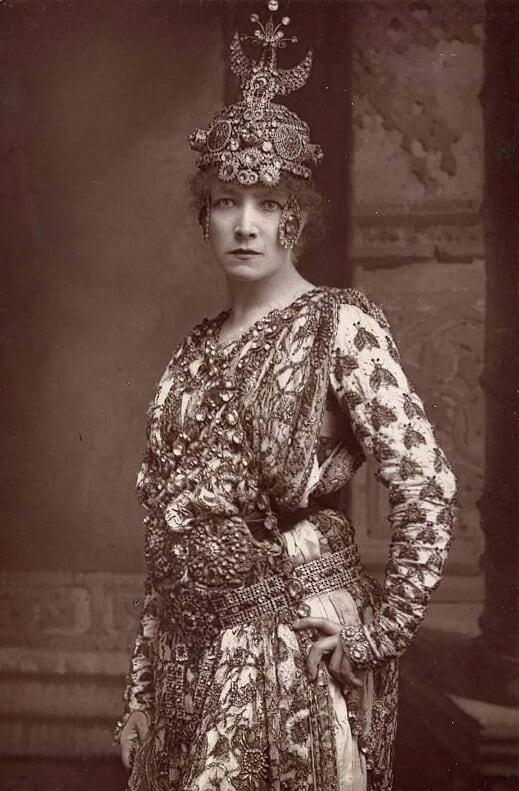‘The Drama of Celebrity’
By • August 21, 2019 0 691

THE CULT OF FAME FOUND AN EARLY GODDESS IN SARAH BERNHARDT
“The Drama of Celebrity” by Sharon Marcus is a hybrid of biography and sociological treatise on one of the most important phenomena of modern times. Marcus, the Orlando Harriman Professor of English and Comparative Literature at Columbia University, sets the table with seven years of scholarly research to show why we are attracted to — or, conversely, repulsed by — celebrity culture.

The Drama of Celebrity by Sharon Marcus.
She begins by defining a celebrity as someone known around the world who has mastered the media and deliberately engaged the public. The aspiring celebrity must connect with the media to reach “the publics,” as Marcus calls them, and ignite the fuse that explodes into fame. All must dance together in a three-way waltz. Without that triangle, Marcus maintains, there can be no celebrity.
Celebrity culture began in the 18th century, when the public began to take an interest in authors, artists, performers, scientists and politicians. Before then, only kings and conquerors were celebrities, which, by Marcus’s definition, were people known during their lifetimes to more people than could possibly know one another.
In profiling the life of French actress Sarah Bernhardt, “the world’s greatest celebrity,” Marcus shows how a contrarian created celebrity culture by toppling tradition and breaking all the rules of conventional behavior. Bernhardt embraced the bizarre by posing in a coffin long before Lady Gaga publicly wore a gown of raw beef (which, by the way, made it to the Rock and Roll Hall of Fame, where it is preserved as jerky).
From the beginning of her career in 1870 until the day she died in 1923, “the divine Sarah” presented herself as the quintessential outsider. She was skinny when fashion prized full figures. French newspapers belittled her for being bony, much as today’s tabloids chide Lena Dunham for being chubby.
Born Jewish, and abandoned by her mother, Bernhardt was baptized Christian and raised in a convent. Yet, in an anti-Semitic world, she insisted on being seen as Jewish and changed her birth name from Rosine to Sarah to emphasize her Hebrew roots, which she knew would make her appear more exotic.
She was the first actress to stare directly at the camera when posing for photographs, an outrageous act for the 19th century, when even the most famous women did not dare to appropriate the self-entitled directness of men. But Bernhardt did, making defiance the first commandment of becoming a celebrity. As Marcus writes, “She dared to show down her beholder.” She also dared to become famous on her own, without benefit of a father or a husband, unheard of for a woman at that time.
Throughout her life, Bernhardt shocked onstage and off; in doing so, she ruled as the most famous person on earth for five decades. She was so popular that theaters had to turn people away at the door of her performances. Touring the globe, she became an international sensation. She was Madonna squared, J-Lo times 10. As Mark Twain said, “There are five kinds of actresses: bad actresses, fair actresses, good actresses, great actresses and Sarah Bernhardt.”
Bernhardt initiated celebrity endorsements when a rice powder (and then a cigar) was named for her. Women imitated her by wearing bunches of flowers the way she did, which paved the way for Audrey pants, Jackie dresses and Farrah’s feathered flip. Bernhardt even became the subject of minstrel acts in which slim men impersonated her as “Sarah Heartburn” and “Sarah Barnyard,” setting the stage for Marilyn look-alikes and Elvis imitators.
The week after Bernhardt’s death, the queen of England ordered a Mass to be said for her at London’s Westminster Cathedral. One obituary noted: “The death of the most famous actress in the world is a fresh reminder that the stage still opens the widest door to the richest realm in which women win honor, fortune and popularity by their own talents and genius.”
A million mourners witnessed her funeral procession travel from her home in Paris to the cemetery. Her name and image dominated international newspaper headlines and magazine covers for weeks after her death, much like Diana, Princess of Wales.
Until the late 20th century, the word “celebrity” was a compliment, a term of genuine praise reserved for those who had accomplished something considered worthwhile, like Helen Keller, Muhammed Ali, Nina Simone and Harry Belafonte, who used their celebrity to fight discrimination against minorities, and others, like Paul Newman and U2’s Bono, who used theirs to further humanitarian causes.
Marcus traces the accolade known as “celebrity” through the centuries to the Kardashian era, when the term became a pejorative of sorts. She ends her book with the example of a man known for his flamboyant headgear, his public boasts about sleeping with other men’s wives, his vast riches and his provocative crudeness, which made him popular with white Americans who felt alienated from the country’s East Coast elites.
She refers, of course, to Davy Crockett (1786-1836), who opened the door for a 21st-century reality star to sit in the White House. Warns the author: “The history and theory of celebrity teach us that we get the celebrities we deserve.”
Georgetown resident Kitty Kelley has written several number-one New York Times best-sellers, including “The Family: The Real Story Behind the Bush Dynasty.” Her most recent books include “Capturing Camelot: Stanley Tretick’s Iconic Images of the Kennedys” and “Let Freedom Ring: Stanley Tretick’s Iconic Images of the March on Washington.”

